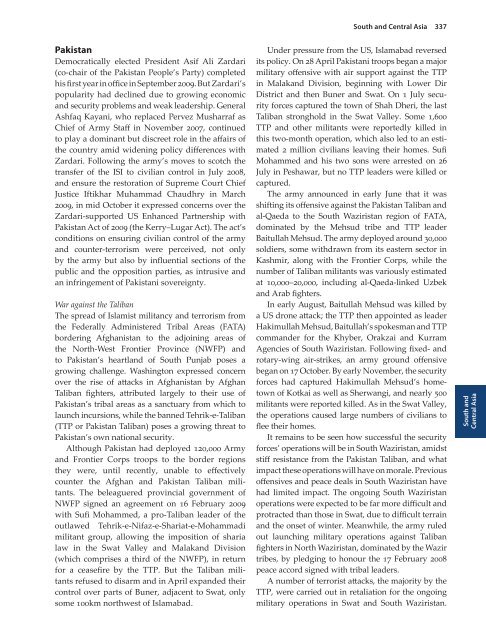You also want an ePaper? Increase the reach of your titles
YUMPU automatically turns print PDFs into web optimized ePapers that Google loves.
Pakistan<br />
Democratically elected President Asif Ali Zardari<br />
(co-chair of the Pakistan People’s Party) completed<br />
his first year in office in September 2009. But Zardari’s<br />
popularity had declined due to growing economic<br />
and security problems and weak leadership. General<br />
Ashfaq Kayani, who replaced Pervez Musharraf as<br />
Chief of Army Staff in November 2007, continued<br />
to play a dominant but discreet role in the affairs of<br />
the country amid widening policy differences with<br />
Zardari. Following the army’s moves to scotch the<br />
transfer of the ISI to civilian control in July 2008,<br />
and ensure the restoration of Supreme Court Chief<br />
Justice Iftikhar Muhammad Chaudhry in March<br />
2009, in mid October it expressed concerns over the<br />
Zardari-supported US Enhanced Partnership with<br />
Pakistan Act of 2009 (the Kerry–Lugar Act). The act’s<br />
conditions on ensuring civilian control of the army<br />
and counter-terrorism were perceived, not only<br />
by the army but also by influential sections of the<br />
public and the opposition parties, as intrusive and<br />
an infringement of Pakistani sovereignty.<br />
War against the Taliban<br />
The spread of Islamist militancy and terrorism from<br />
the Federally Administered Tribal Areas (FATA)<br />
bordering Afghanistan to the adjoining areas of<br />
the North-West Frontier Province (NWFP) and<br />
to Pakistan’s heartland of South Punjab poses a<br />
growing challenge. Washington expressed concern<br />
over the rise of attacks in Afghanistan by Afghan<br />
Taliban fighters, attributed largely to their use of<br />
Pakistan’s tribal areas as a sanctuary from which to<br />
launch incursions, while the banned Tehrik-e-Taliban<br />
(TTP or Pakistan Taliban) poses a growing threat to<br />
Pakistan’s own national security.<br />
Although Pakistan had deployed 120,000 Army<br />
and Frontier Corps troops to the border regions<br />
they were, until recently, unable to effectively<br />
counter the Afghan and Pakistan Taliban militants.<br />
The beleaguered provincial government of<br />
NWFP signed an agreement on 16 February 2009<br />
with Sufi Mohammed, a pro-Taliban leader of the<br />
outlawed Tehrik-e-Nifaz-e-Shariat-e-Mohammadi<br />
militant group, allowing the imposition of sharia<br />
law in the Swat Valley and Malakand Division<br />
(which comprises a third of the NWFP), in return<br />
for a ceasefire by the TTP. But the Taliban militants<br />
refused to disarm and in April expanded their<br />
control over parts of Buner, adjacent to Swat, only<br />
some 100km northwest of Islamabad.<br />
South and Central Asia<br />
337<br />
Under pressure from the US, Islamabad reversed<br />
its policy. On 28 April Pakistani troops began a major<br />
military offensive with air support against the TTP<br />
in Malakand Division, beginning with Lower Dir<br />
District and then Buner and Swat. On 1 July security<br />
forces captured the town of Shah Dheri, the last<br />
Taliban stronghold in the Swat Valley. Some 1,600<br />
TTP and other militants were reportedly killed in<br />
this two-month operation, which also led to an estimated<br />
2 million civilians leaving their homes. Sufi<br />
Mohammed and his two sons were arrested on 26<br />
July in Peshawar, but no TTP leaders were killed or<br />
captured.<br />
The army announced in early June that it was<br />
shifting its offensive against the Pakistan Taliban and<br />
al-Qaeda to the South Waziristan region of FATA,<br />
dominated by the Mehsud tribe and TTP leader<br />
Baitullah Mehsud. The army deployed around 30,000<br />
soldiers, some withdrawn from its eastern sector in<br />
Kashmir, along with the Frontier Corps, while the<br />
number of Taliban militants was variously estimated<br />
at 10,000–20,000, including al-Qaeda-linked Uzbek<br />
and Arab fighters.<br />
In early August, Baitullah Mehsud was killed by<br />
a US drone attack; the TTP then appointed as leader<br />
Hakimullah Mehsud, Baitullah’s spokesman and TTP<br />
commander for the Khyber, Orakzai and Kurram<br />
Agencies of South Waziristan. Following fixed- and<br />
rotary-wing air-strikes, an army ground offensive<br />
began on 17 October. By early November, the security<br />
forces had captured Hakimullah Mehsud’s hometown<br />
of Kotkai as well as Sherwangi, and nearly 500<br />
militants were reported killed. As in the Swat Valley,<br />
the operations caused large numbers of civilians to<br />
flee their homes.<br />
It remains to be seen how successful the security<br />
forces’ operations will be in South Waziristan, amidst<br />
stiff resistance from the Pakistan Taliban, and what<br />
impact these operations will have on morale. Previous<br />
offensives and peace deals in South Waziristan have<br />
had limited impact. The ongoing South Waziristan<br />
operations were expected to be far more difficult and<br />
protracted than those in Swat, due to difficult terrain<br />
and the onset of winter. Meanwhile, the army ruled<br />
out launching military operations against Taliban<br />
fighters in North Waziristan, dominated by the Wazir<br />
tribes, by pledging to honour the 17 February 2008<br />
peace accord signed with tribal leaders.<br />
A number of terrorist attacks, the majority by the<br />
TTP, were carried out in retaliation for the ongoing<br />
military operations in Swat and South Waziristan.<br />
South and<br />
Central Asia


